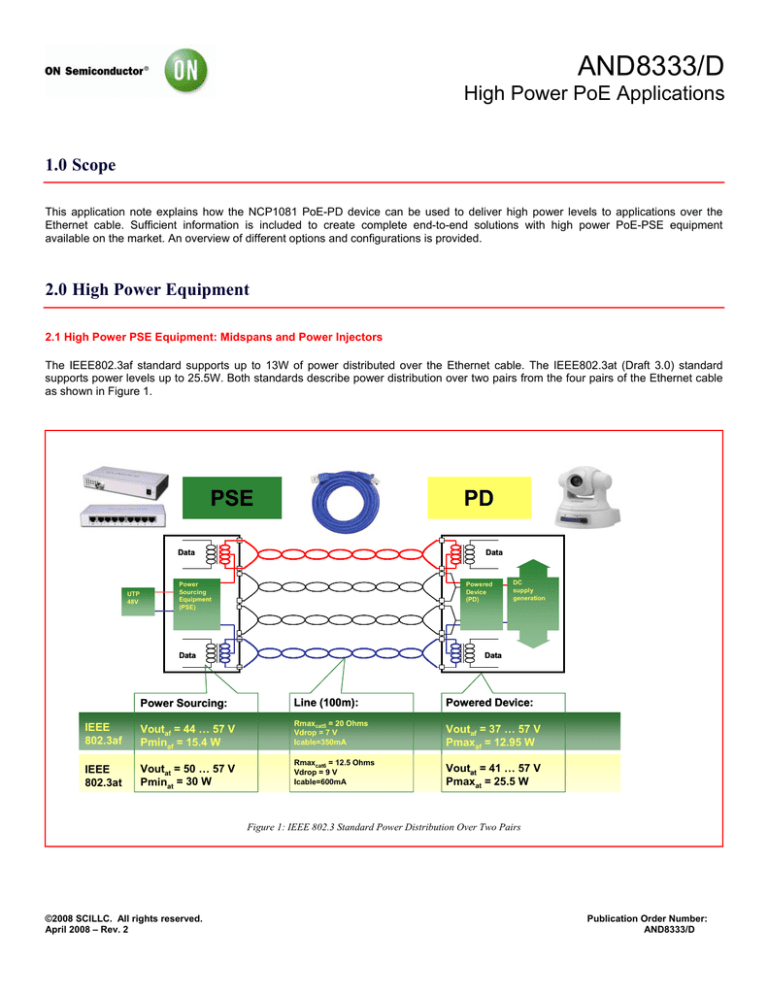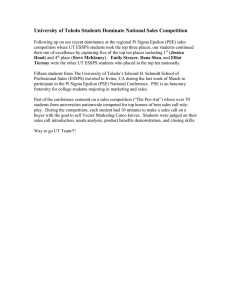
AND8333/D
High Power PoE Applications
1.0 Scope
This application note explains how the NCP1081 PoE-PD device can be used to deliver high power levels to applications over the
Ethernet cable. Sufficient information is included to create complete end-to-end solutions with high power PoE-PSE equipment
available on the market. An overview of different options and configurations is provided.
2.0 High Power Equipment
2.1 High Power PSE Equipment: Midspans and Power Injectors
The IEEE802.3af standard supports up to 13W of power distributed over the Ethernet cable. The IEEE802.3at (Draft 3.0) standard
supports power levels up to 25.5W. Both standards describe power distribution over two pairs from the four pairs of the Ethernet cable
as shown in Figure 1.
PSE
PD
Data
UTP
48V
Data
Power
Sourcing
Equipment
(PSE)
Powered
Device
(PD)
Data
Power Sourcing:
IEEE
802.3af
Voutaf = 44 … 57 V
Pminaf = 15.4 W
IEEE
802.3at
Voutat = 50 … 57 V
Pminat = 30 W
DC
supply
generation
Data
Line (100m):
Rmaxcat5 = 20 Ohms
Vdrop = 7 V
Icable=350mA
Rmaxcat6 = 12.5 Ohms
Vdrop = 9 V
Icable=600mA
Powered Device:
Voutaf = 37 … 57 V
Pmaxaf = 12.95 W
Voutat = 41 … 57 V
Pmaxat = 25.5 W
Figure 1: IEEE 802.3 Standard Power Distribution Over Two Pairs
©2008 SCILLC. All rights reserved.
April 2008 – Rev. 2
Publication Order Number:
AND8333/D
AND8333
The higher power level for the IEEE802.3at standard is accomplished by raising the minimum IEEE803.3af standard voltage on the
cable from 44V to 50V. CAT5e/6 cable is proposed for high power applications due to lower resistance. The power level in IEEE802.3at
is increased from 13W to 25.5W by also changing the maximum cable current from 350mA to 720mA. Note that the 25.5W power
budget is not fully available for the PD load due to losses which occur in the PD circuit between the Ethernet input jack and the voltage
regulator output. Power losses occur in the DC-DC converter block, in the input diode bridge and also in the PoE-PD device. An overall
efficiency of 85 percent is realistic. This results in an application power budget of 11W for IEEE802.3af and 20.4W for IEEE802.3at.
Table 1: Power Budget Levels
Cable (length 100m)
Pairs used
Cable resistance (Ohm)
Max. current per pair (mA)
Voltage by PSE (V)
Power by PSE (W)
Max. cable power loss (W)
Input power PD (W)
Efficiency of PD+ converter
Output power PD (W)
Overall efficiency
IEEE 802.3af
Cat 3
2
20
350
44
15.4
2.4
12.9
85%
11.0
71%
IEEE 802.3at
Cat 5e
2
12.5
600
50
30
4.5
25.5
85%
20.4
70%
Option A
Cat 5e
2
12.5
720
56
40.3
6.48
33.8
85%
28.7
71%
Option B
Cat 5e
2
12.5
1100
56
61.6
15.1
46.4
85%
39.5
64%
Option C
Cat 5e
4
12.5
550
56
61.6
7.5
54.0
85%
45.9
75%
Option D
Cat 5e
4
12.5
720
56
80.6
12.9
67.6
85%
57.5
71%
Some PoE applications require more power than the 25.5W possible with the IEEE802.3at (Draft 3.0) standard which limits the current
to 600mA. The mean reason for this limit is to reduce the generation of heat when a large number of Ethernet cables are bundled.
Fortunately, it is possible to achieve higher power levels with proprietary configurations. Option A achieves higher power levels by
increasing the minimum voltage level to 56V and the current up to 720mA. Option B combines raising the voltage to 56V and the
current to 1100mA over two pairs. Option C delivers more output power than Option B but distributed over four pairs with a lower
current 520mA per pair. Option D delivers about twice the power of Option A by distributing power over four pairs instead of two.
Figure 2: PoE Injector
Midspans are multiport power injectors placed in series with switches. An injector is a single port midspan. Figure 2 gives an overview
on how a single port midspan (injector) injects power into the Ethernet cable. The power is retrieved from the cable via a splitter box.
The NCP1081 can replace the high power splitter box delivering the required high power levels.
Rev. 2 | Page 2 of 8 | www.onsemi.com
AND8333
Table 2 lists high power PSE switches, midspans and injector equipment currently available on the market. Two- and four-pair
configurations are available.
• Phihong
o
o
o
o
Phihong has midspans and injectors in their product line.
Phihong has two-pair configurations up to 30W and 36W and four-pair versions up 60W and 80W. The four-pair
configurations have proprietary detection and the two-pair configurations have Class 4 classification. Class 4
classification does not include a Layer 2 handshake since the midspan had no data communication channel.
One NCP1081 device in combination with the Phihong two-pair 36W device can deliver 25W output power to the
application with Class 4 classification (single-finger IEEE802.3at classification).
Two NCP1081 devices in combination with the Phihong two-pair Option C and D approach can be implemented with
four-pairs to deliver more than 40W to the application.
• Korenix
o
Korenix has Ethernet switches with 30W per port. The equipment uses Class 4 and some include Layer 2
handshaking.
The NCP1081 can only deliver 20W to the application in combination with this equipment.
o
o
Panduit midspan delivers 30W per port. Classification is via Class 4 without Layer 2 handshaking.
The NCP1081 can only deliver 20W to the application in combination with this equipment.
o
• Panduit
Table 2: Overview of High Power PSE Equipment
Company Type
Name
Power
Watt
Phihong
Korenix
Panduit
Injector
Injector
Injector
POE20U
POE30U
POE60U
19.6
30
60
PSE Power
Power
Output/Port
19.6
30
60
PD Power
PD Output
Ports
Pairs
Voltage
Volt
14
20
40
1
1
1
2
2
4
56
56
56
Current
mA/per
Pair
350
550
550
Injector
POE80U
80
80
57
1
4
56
720
Midspan
POE480U-4UP
240
60
40
4
4
?
?
Midspan
POE480U-8UP
480
60
40
8
4
?
?
Midspan
Midspan
Switch
Switch
Midspan
POE576U-8HP
POE576U-16HP
Jetnet 4706
Jetnet 3706
DPOE8
288
576
120
120
240
36
36
30
30
30
25
25
20
20
20
8
16
4
4
8
2
2
2
2
2
?
?
55
55
?
550
550
650
650
?
Handshake
Class 4
Class 4
Proprietary 12.5K
detection
Proprietary 12.5K
detection
Proprietary 12.5K
detection
Proprietary 12.5K
detection
Class 4
Class 4
Class 4 Layer 2
Class 4 Layer 2
Class 4
2.2 Handshaking Protocols
The NCP1081 can handle all defined types of handshaking and is compatible with all the PSE equipment described above.
The classification process defined in the high power IEEE802.3at standard extends beyond the one defined in the low power 802.3af
standard because it can be done in several ways. First the classification current in the PoE-PD must be set to the Class 4. Then the
PoE-PD can be classified by the IEEE802.3at PSE based on Two Event Physical Layer classification (so called Layer 1), Data Link
Layer classification (so called Layer 2) or a combination of both. However, high power PSE which are non compliant with the previous
process can also be used with the NCP1081 if they use a proprietary current classification.
These handshaking protocols are explained in more detail in the following paragraphs.
2.2.1. High Power Classification: Two Event Physical Layer Classification (Layer 1)
This first method is characterized by a classification event being performed twice, meaning the PSE forces the PD to enter in the
classification range two times. This is implemented in the hardware of the PSE and PD devices. Interest in this Layer 1 approach is
mainly driven by the need for basic midspan equipment where it is desirable to avoid having to access the data channel stream. None
of the equipment above is using this classification principle but the standard is evolving in this way for midspans and injectors.
Rev. 2 | Page 3 of 8 | www.onsemi.com
AND8333
2.2.2. High Power Classification: Layer 2 Classification
A PSE performing Layer 2 classification classifies the PD in two phases. In the first phase the PSE performs a physical classification
with one event (same procedure used in the IEEE802.3af standard). The classified PD is then powered up by the PSE under low power
conditions, meaning that the power can not exceed the IEEE802.3af limits. The second phase occurs a very short period after powerup; the PD will communicate its required power level to the PSE via an Ethernet data packet. The IEEE802.3at draft specification
suggests using the link layer discovery protocol (LLDP) according to the IEEE802.1AB-2005 specification that is being reworked and
follows the messages described in the IEEE802.3at specification.
The designer will have to implement a LLDP agent, a software routine implementing a state machine that is providing access to the
internal data base of the network device. Not all of the databases, such as management information base (MIB) that are commonly
accessible via LLDP need to be implemented, but for sure the IEEE802.3at power management data sets needs to be implemented.
2.2.3. High Power Classification: Proprietary
A third method is proprietary. Since most midspan equipment does not currently support Layer 1 handshaking, most of the PSE
equipment today uses a proprietary classification, typically using a one event physical classification handshake.
• Proprietary detection resistors are possible to enable four-pair configurations. The Phihong equipment uses a 12.5K Ohm resistor
instead of 25K Ohm detection resistor.
• Another option is to use a one event Layer 1 classification using Class 4 to enable higher power levels without doing a Layer 2
classification. Most of the equipment above is using this principle. This principle is actually a single-finger Layer 1 handshake with
reserved Class 4.
2.2.4. Handshaking Indication
The nCLASS_AT pin on the NCP1081 indicates to the microcontroller if a two event physical classification event occurred. Once it has
been detected, the nCLASS_AT open drain pin goes low. In all other conditions, such as a one event physical classification handshake,
the nCLASS_AT pin stays high.
Powered Device Application
Csup
VSUP
VDDL
VDDL
Layer 2
Engine
Rbip
Rled
20 uA
nCLASS_AT
IN1
Microprocessor or
Microcontroller
IN2
Opto1
Class_AT
ARTN
Features
GND
NCP1081
Isolation
(Isolated DC/DC converter)
Figure 3: nCLASS_AT Pin
• Connecting the NCP1081 to a Phihong midspan keeps the nClass_AT pin high.
• Connecting to an IEEE802.3at compliant midspan will bring the nClass_AT pin low.
Rev. 2 | Page 4 of 8 | www.onsemi.com
AND8333
3.0 High Power Configurations
3.1 20W or 30W Single Output
Cpd
VPORTP
RJ-45
Rclass
CLASS
VDDH
D1
T1
Voutput
Cvddh
Rinrush
INRUSH
VDDL
Cline
DB1
Z_line
Data
Pairs
NCP1081
R1
Rd1
nCLASS_AT
UVLO
R2
M1
GATE
TEST2
CS
OSC
SS
VPORTN2
COMP
VPORTN1
R5
Rslope
FB
TEST1
DB2
LD1
Cload
ILIM1
Spare
Pairs
Cvddl
Rilim1
ARTN
OC1
Rcs
R3
C2
RTN
Optocoupler
C1
Rosc
Css
Z1
R4
Figure 4: 30W, Two-Pair, Single Output Configuration
• The POE30U midspan can deliver 30W of power to the cable by injecting 550mA at 56V. A single NCP1081 delivers 20W to a 24V
output. The PoE-PD efficiency from input RJ45 jack to output is estimated to be 85 percent. Using a Cat5e 100m cable results in an
overall efficiency from PSE output to PD converter output of 75 percent.
• The POE480U-4P can deliver 36W of power to the cable by injecting 720mA at 56V. A single NCP1081 delivers 25W to a 24V
output. The PoE-PD efficiency from input RJ45 jack to output is estimated on 85 percent. Using a Cat5e 100m cable results in an
overall efficiency from PSE output to PD converter output of 71 percent.
• The power can be increased to higher power levels by increasing the voltage or current limit.
• Connecting the NCP1081 to a Phihong midspan keeps the nClass_AT pin high.
Rev. 2 | Page 5 of 8 | www.onsemi.com
AND8333
3.2 60W or 80W Triple Output
Figure 5: 80W, Four-Pair, Triple Output Configuration
• The POE60U midspan can deliver 60W of power to the cable by injecting 550mA at 56V. Dual NCP1081’s deliver 25W to a 24V
output, 20W to a 12V output and 5W to a 3.3V output. The PoE-PD efficiency from input RJ45 jack to output is estimated to be 85
percent. Using a Cat5e 100m cable results in an overall efficiency from PSE output to PD converter output of 75 percent.
• The POE80U midspan can deliver 80W of power to the cable by injecting 720mA at 56V. Dual NCP1081’s deliver 34W to a 24V
output, 30W to a 12V output and 4W to a 3.3V output. The PoE-PD efficiency from input RJ45 jack to output is estimated to be 85
percent. Using a Cat5e 100m cable results in an overall efficiency from PSE output to PD converter output of 71 percent.
• Connecting the NCP1081 to a Phihong midspan keeps the pin nClass_AT high.
Rev. 2 | Page 6 of 8 | www.onsemi.com
AND8333
3.3 60W or 80W Dual Output
Figure 6: 80W, Four-Pair, Dual Output Configuration
• The POE60U midspan can deliver 60W of power to the cable by injecting 550mA at 56V. Dual NCP1081’s deliver 25W to a 24V
output and 25W to a 12V output. The PoE-PD efficiency from input RJ45 jack to output is estimated to be 85 percent. Using a Cat5e
100m cable results in an overall efficiency from PSE output to PD converter output of 75 percent. Other voltages can be derived from
the 12V output with a separate DC-DC converter.
• The POE80U midspan can deliver 80W of power to the cable by injecting 720mA at 56V. Dual NCP1081’s deliver 34W to a 24V
output and 34W to a 12V output. The PoE-PD efficiency from input RJ45 jack to output is estimated to be 85 percent. Using a Cat5e
100m cable results in an overall efficiency from PSE output to PD converter output of 71 percent. Other voltages can be derived from
the 12V output with a separate DC-DC converter.
• Connecting the NCP1081 to a Phihong midspan keeps the pin nClass_AT high.
Rev. 2 | Page 7 of 8 | www.onsemi.com
AND8333
4.0 Company or Product Inquiries
For more information about ON Semiconductor’s Power over Ethernet products visit our Web site at http://www.onsemi.com
5.0 Revision History
Date
January 2008
April 2008
Version
1.0
2.0
Modifications
Initial release
General update
ON Semiconductor and
are registered trademarks of Semiconductor Components Industries, LLC (SCILLC). SCILLC reserves the right to make changes without further
notice to any products herein. SCILLC makes no warranty, representation or guarantee regarding the suitability of its products for any particular purpose, nor does SCILLC
assume any liability arising out of the application or use of any product or circuit, and specifically disclaims any and all liability, including without limitation special,
consequential or incidental damages. “Typical” parameters which may be provided in SCILLC data sheets and/or specifications can and do vary in different applications and
actual performance may vary over time. All operating parameters, including “Typicals” must be validated for each customer application by customer's technical experts.
SCILLC does not convey any license under its patent rights nor the rights of others. SCILLC products are not designed, intended, or authorized for use as components in
systems intended for surgical implant into the body, or other applications intended to support or sustain life, or for any other application in which the failure of the SCILLC
product could create a situation where personal injury or death may occur. Should Buyer purchase or use SCILLC products for any such unintended or unauthorized
application, Buyer shall indemnify and hold SCILLC and its officers, employees, subsidiaries, affiliates, and distributors harmless against all claims, costs, damages, and
expenses, and reasonable attorney fees arising out of, directly or indirectly, any claim of personal injury or death associated with such unintended or unauthorized use, even
if such claim alleges that SCILLC was negligent regarding the design or manufacture of the part. SCILLC is an Equal Opportunity/Affirmative Action Employer. This literature
is subject to all applicable copyright laws and is not for resale in any manner.
PUBLICATION ORDERING INFORMATION
LITERATURE FULFILLMENT:
Literature Distribution Center for ON Semiconductor
P.O. Box 5163, Denver, Colorado 80217 USA
Phone: 303-675-2175 or 800-344-3860 Toll Free USA/Canada
Fax: 303-675-2176 or 800-344-3867 Toll Free USA/Canada
Email: orderlit@onsemi.com
N. American Technical Support: 800-282-9855
Toll Free USA/Canada
Europe, Middle East and Africa Technical Support:
Phone: 421 33 790 2910
Japan Customer Focus Center
Phone: 81-3-5773-3850
Rev. 2 | Page 8 of 8 | www.onsemi.com
ON Semiconductor Website: www.onsemi.com
Order Literature: http://www.onsemi.com/orderlit
For additional information, please contact your local
Sales Representative



